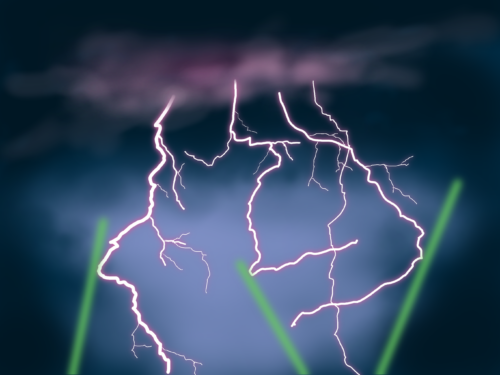Image Courtesy of Kara Tao.
For the first time, scientists have successfully used lasers to divert lightning in real-world experiments. During the summer of 2021, a team of around twenty-five scientists used a rapid-firing laser to redirect lightning, moving it more than fifty meters. Their results will pave the way toward improved lightning protection for airports, launchpads, and other large infrastructures.
During storms, charges accumulate in clouds. When this build-up becomes too large, there is a rapid discharge of electricity, called lightning. Classical metal Franklin lightning rods provide a preferential channel for the discharge to reach the ground. This way, they guide lightning away from houses and small structures. “They protect roughly an area with a radius corresponding to their length,” said Aurélien Houard, a researcher at École Polytechnique in France and the leading author of the Nature paper detailing the team’s results. However, Franklin rods rarely protect areas with a radius greater than thirty meters. “What we want with the laser is to increase the range of protection,” Houard said.
Much like a Franklin rod, lasers create a preferential channel for lightning. The difference is that they do so using air rather than metal. When a high-intensity laser is fired rapidly enough, it heats up the air in its path and transforms it into plasma by turning the gas particles into charges. This phenomenon creates a tunnel with very high conductivity through which lightning can travel. The biggest advantage is that lasers can reach higher in the sky than any metal rod and can point in multiple directions.
Guiding lightning with lasers was first achieved in the lab over twenty years ago. But diverting lightning by two meters in a controlled laboratory setting is child’s play compared to doing it over tens of meters in an unpredictable storm. Calculations and simulations showed that only rapid-firing lasers would reproduce the lab results in the real world. “Although it worked on paper, we had to convince someone to build that laser up for us,” said Jean-Pierre Wolf, professor of physics at the University of Geneva. “When I was at Yale [on sabbatical] in 2000, I was already talking about lightning control with lasers. It’s been a very long-term project.” It was only six years ago that new laser technology and funding sources came together to create a laser capable of firing at the necessary one thousand pulses per second at an intensity of roughly one terawatt, or one million million watts.
French, Swiss, and German scientists came together in a highly collaborative research team determined to show the capabilities of the laser. They chose a telecoms tower at the top of Säntis Mountain in Switzerland, a location with a high rate of lightning strikes, equipped with multiple sensors for accurate lightning measurements. During six hours of operating the laser in thunderstorms, they recorded four successful lightning redirection events. Out of these, only one happened in good enough conditions to be recorded by high-speed cameras. The footage showed that the lightning strike followed the plasma conductive channel created by the laser over a fifty-meter distance.
Working with lightning in the field is challenging because of its unpredictability. On top of that, the research team couldn’t use the laser at all times. “When the air traffic was very heavy, in the morning, for instance, we weren’t allowed to shoot,” Wolf said. “We were lucky to have four events where the laser was on, and everything was operating correctly.” Ideally, the research team would have tested the different wavelengths the laser can emit: infrared, visible green, or ultraviolet. But due to their time constraints, the team only tested infrared radiation.
Ultraviolet light ionizes the air more easily but does not travel as well through the air, while infrared radiation has the opposite characteristics. Both Houard and Wolf are optimistic that green light would be the best option. “We would also need to better characterize the ability of the plasma to trigger and guide lightning. All of these parameters are not very well known,” Houard said. After all, this project was only a demonstration experiment. “We would need much more experimental characterization before we can really claim that we can protect a large area with this [system].”
Despite the promise of increased lightning protection, it could be anywhere between five and fifteen years before this project comes to fruition. Scientists are essential for these first steps of characterization and optimization, but it will be an engineering challenge to create compact and cost-effective laser-based technology for lightning protection in the future.

